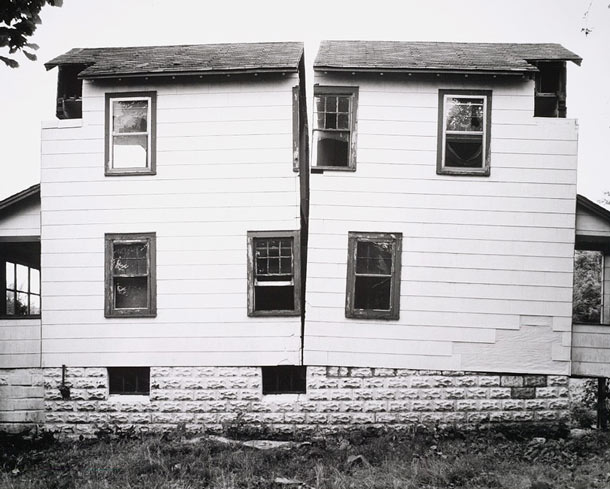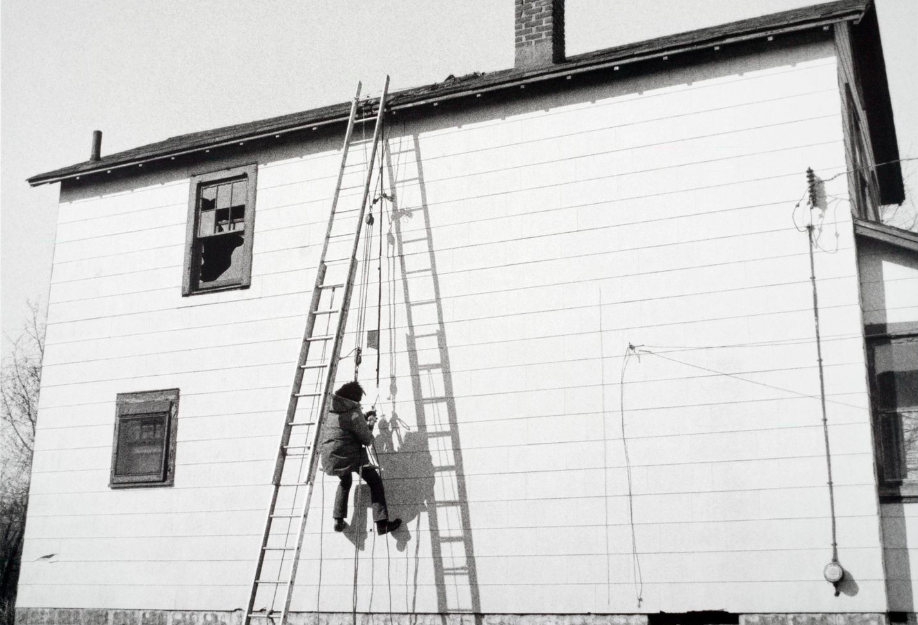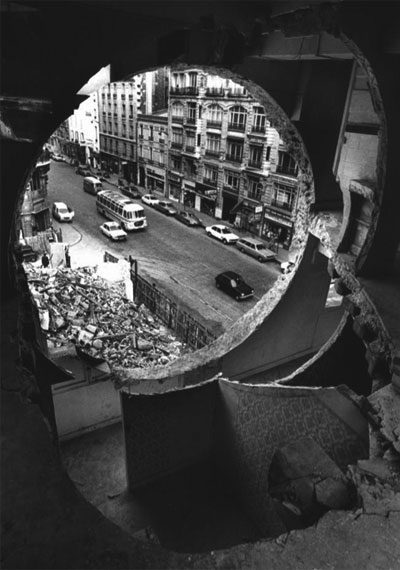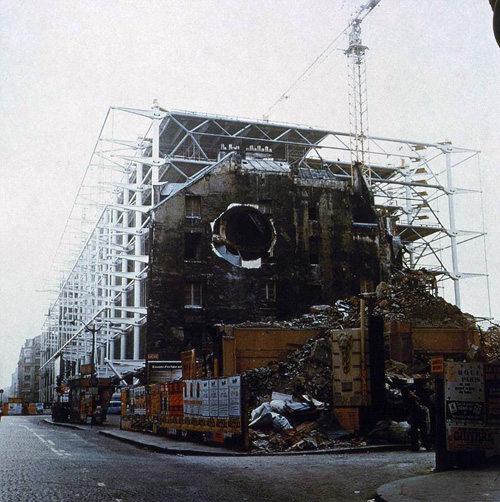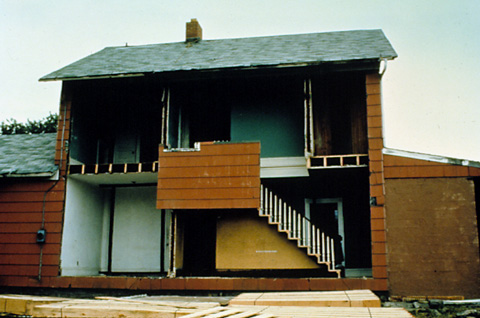スラム学 第2回【スラムを無意識の社会運動として考える】
Slumics Vol.2 【Thinking of slum as an unconscious social movement】
[建物を切断し、空間をつなげるという手法]
「分裂(Splitting)」(1974年、写真左)や「デイズ・エンド(Day’s End)」(1975年、写真右)の作品で知られている芸術家、ゴードン・マッタ=クラーク(1943-1978)の床や壁を切断するプロジェクトは、都市の再開発に伴う空間の効率的な再編や空間の均質化に対する批判という側面をもっている。彼は、大学でコーリン・ロウというモダニズム建築理論家のプログラムの下で建築を学び訓練を受けた。その過程で近代建築に強い疑問を抱き、卒業後は建築実務の道には進まずアーティストになる。彼の作品の面白さは、建物をまるで物のように扱っている所にある。彼の作品の批評性は、建築設計の訓練を受けた者が模型作りという設計手法を身につけたことで可能となっている。彼は、模型作りを、建築批判の手法にしてしまった。建築に対する批判が、その建築設計手法を用いて示されているという類まれな作品である。それは自分の頭を自分で作ったハンマーで叩かれているようなものである。これが、前回にも述べた、物事を内側から変えていくことの一例である。
[The techniques that cut a building and connect spaces]
Gordon Matta-Clark was the artist best known for his art works “Splitting” (1974, photo left) and “Day’s End” (1975, photo right). His projects, that cut walls and floors, are the criticism about the redevelopment of city which causes stereotypical reorganization and homogeneity of space. He was trained as an architect under the program guided by Colin Rowe, an architectural theorist of modernism. He did not practice as a conventional architect and became an artist after leaving from his university. The uniqueness of his art works is the point where he deals with a building as an object. The criticism that his works have results from his learning of the architectural technique like a model making. He turned the model making technique into the technique for the architectural criticism. His works are the exceptional samples that the criticism against architecture was shown by the architectural technique itself. This is like that one’s head is hit by the hammer that he made. This is an example of the way to change things from its inside, I mentioned in the last article.
建築家は建物を設計する際に、両手で操作可能なサイズに縮尺された模型を使って、構造や間取りやデザインを考える。壁や床をカッターで切断したり、新しい柱を取り付けたり、そしてまた剥がしたりと、一つの模型がボロボロになるまで変更を加える。実際の建物を建設中に大きく設計変更をすることは難しいけれども、模型であれば何度でも変更を加えることができる。スラムの建物は作りながら住まいながら変更が加えられていくという点で、この模型作りの考え方と非常によく似ている。
An architect thinks of structure, plan and design of a building with models scaled down to the size in which he can handle with his hands. He makes many changes in a model while cutting walls and floors with a knife, adding some columns and dismantling them until it gets worn-out. Although it is difficult to make a big change in the actual building under construction, it is easy to make many changes in a building model. It resembles to the model making technique that people can make a change while making and living in their houses in slum.
[住まいのニーズ]
『アジア・アフリカの都市コミュニティ』という本の中で、「スラム居住者が必要としている住宅は、完成されたものではなく、必要に応じて手を加えていくものである。スラム居住者は自由に空間を拡張したり、住まい方を調整できるような柔軟性を住宅に求めている」と述べられている。彼らは家計、季節、家族構成などの状況に応じてその都度住まい方を変更していく必要があるのだ。自分たちの生活を環境に合わせてその都度変更し、またいつでも変更できるように準備しておく彼らの生活は、持続可能(サステイナブル)な暮らしの一側面を体現していると言っても良いであろう。
[Needs of housings]
In the book “Urban Community in Asia and Africa”, it is mentioned that “the housing that slum inhabitants need is not finished one but one that they can update. They require for their housings flexibility where they can extend space and adjust the way of their living.” It is necessary for them to alter the way of their living according to household economy, seasons and family make-up. Their flexible lives to the environment embody an aspect of sustainability.
知りうる限りでは、上のようなスラムはアジアで多く見られ、東アフリカでは一度建てたら終わりで増改築を繰り返しているものは少ない。それは、土地の広さとスラム住民の人口数と建設技術から由来するのかもしれない。土地が広ければ、人口が増えても建物を上方に増築する必要がなく、増改築する建設技術がなければ溢れた住民は他の土地に移りそこで住処を見つけるしかない。技術だけではなく、その土地で手に入れることができる素材にもスラムの建物は左右される。ブルーシート、ベニヤ、木材、竹、トタン板、レンガ、コンクリートブロック、土など安価にもしくは無料で手にはいる素材が、スラムの建物には使われている。これらの素材の新たな使い方や安価な素材の開発などを住人と一緒に試みることは、スラムの未来を考える上で一つの効果的な手段になり得ると思う。
As long as I know, there are more slums like these in Asia. Most of slums in East Africa do not extend and alter their housing so many times. It would result from large land, the number of population of inhabitants and their construction technique. There is no necessity to extend a housing upward in large land even if the number of population increase. Lacking in construction technique, an inhabitant, who do not have a housing, have to move and settle in another slum. The housing in slum is influenced by not only technique but also the material that is available in their area. The cheap and free materials are used for slum housings, such as blue sheeting, plywood, timbers, bamboo, corrugated galvanized iron, bricks, concrete blocks, mud and so on. It could be effective means for their future living towards a sustainable city to try to think another way of using these materials and to invent new cheap materials together with the inhabitants.
[DIYと近隣との調和]
スラムの建物の特徴は、DIY性とご近所さんとの調和にある。スラムの建物は、どこからが内部でどこまでが外部か、どこからが住居でどこからが職場であるのかの区別がつき難くかったり、そもそも建物と言うより構築物と呼んだ方が良さそうなものが多い。基本的に住民は自分達で建物を作る。そのため欠陥も多いけれども、使いこなしていくうちにその欠陥が特徴となり長所となる。欠陥を長所に思えるようになると、その特徴を利用して増改築しようとする発想が生まれてくる。このアイディアがスラムをユニークに発展させる。専門家に頼らず、近所の住人と話し合い、交渉し、喧嘩しながら、考える。だから、近隣との調和が取れたユニークな建物が出来上がる。この建物が、そこで暮らす人たちの人間関係や家族のあり方もユニークにする。とは言うものの、ほとんどの場合は苦し紛れにその場しのぎで出した妥協策から生まれた調和である。それ故に、突然変異的で予想もしないような、時には無茶苦茶な建物が出来上がる。もちろんここには国が定めるような建築基準法がないから、このような自由な建物ができるのである。
[DIY and harmony with neighborhood]
The characteristics of housings in slum are DIY and harmony with its neighborhood. It is hard to distinguish inside from outside and a living space from a working place in the housings. Most of them are something that we can call not housings but structures. Basically, they build their housings by themselves. Therefore, the housings have defects. While living with these defects, they become character and after all merit. Taking the defects as merits, these merits start to inspire inhabitants with extension and structural alteration of housings. These inspirations uniquely develop slum. The inhabitant thinks about his housing while discussing, negotiating and fighting with neighbors without depending on experts. That is why unique housings generate harmonious with neighborhood. These housings also make human relationship and style of family unique. Having said this, in the most of case, the harmony results from a compromise made up as a stopgap measure. Consequently, the housings that are mutational, beyond expectation and sometimes acrobatic, were born because there is no building regulation here established by the government.
DIY=Do It Yourselfとは、第二次世界大戦でドイツ軍の激しい空襲を受けたロンドンで戦後に始まった、破壊された街を自分たちの手で復興させようとする国民運動のスローガンであった。そして、それは国や自治体に頼らず自分たちの生活は自分たちで作ろうという政治社会運動にも繋がって行った。スラムの住人たちは、ただ必要に迫られて自分たちの手で何もかもやらざるを得ないだけなのだが、無意識にDIY運動以上の結果を出している。切実さといった原初的な欲求の方が思想を上回っている。こう言った住環境に対するやりとりが、ここでの人間関係もユニークなものにする。
DIY=Do It Yourself is a slogan of the movement that started after World War Ⅱto reconstruct by themselves the city of London destructed by air raid. And it becomes the political social movement where people try to make their own lives by themselves without depending on the government. Although the inhabitants in slum just have to make everything by themselves by necessity, they unconsciously produce better results than the DIY movement. Desideratum exceeds thought. Such communication about living environment makes human relationship unique here.
[スラムのユニークな人間関係]
家族とは、国家における最小単位であり、国が管理しやすいよう法によりそのあり方が定められている。家族がしっかりと統率されていることが望まれているために、一家族の社会的権利が存在し、それ故に一家族のプライバシーが尊重され、住宅もその一家族のプライバシーを守るように設計されている。住宅は、基本的には玄関は一つで、他人が無断でそこに立ち入ることは出来ず、近隣からはその中で何が起こっているのかわからないブラックボックスとして存在する。近代建築技術とセキュリティーに対する考えとエアコンというテクノロジーが住宅を密閉された容器にし、ブラックボックス化を補強してきた。こうして、近代住宅建築が近代家族を他人が立ち入りにくい最も閉じられた人間関係にしてきた。もちろん土地制度もこれに加担している。だから、スラムでは、テクノロジーを購入できないことや、国の管理や土地制度さらには建築基準法がない故に、独特の建物の形態が生み出され、家族の形態と近隣との人間関係が独特の様相を帯びている。
[Unique human relationship in slum]
Family is the smallest unit in a country and what family should be like is established in law by the government to make it manageable. Because it needs family to well-govern itself, family has a social right and its privacy is respected. So, a housing is also designed to protect the privacy of a family. A housing basically has a single entrance and stranger cannot come in without permission. It is the black box where people cannot tell from outside what is happening inside. Modern architectural technique, security and an air conditioner make it a sealed container so as to reinforce the idea of a black box. Modern housing architecture make modern family the most closed human relationship that others cannot enter. Land system also take part in this. Since, in the slum, the inhabitants cannot afford technology and there is no land system, no building regulation and no administration, the form of buildings, family and neighborhood become different from that of modern city.
[スラムを無意識の社会運動として考える]
このように近代国家の管理から免れていること、ここにスラムの可能性がある。営利企業が提示する上辺だけの循環型(サステイナブル)社会構想ではなく、DIY運動が目指したような、近代国家を乗り越える真の循環型(サステイナブル)社会を実現するためのアイディアがここにたくさん詰まっているのである。スラムが持つ、自分たちで容易に変更可能な手作りの環境づくりの文化は、持続可能な社会のロールモデルとなりえる。住人が住環境に手を加える際に、ゴードンの様な発想力と大胆さ、そして建材の特性の活かし方などが加わればさらに良くなる。
[Thinking of slum as an unconcious social movement]
Slum is not under modern national administration. This is the potential of it. There are many ideas in slum to realize a sustainable society beyond modernism, aimed by the DIY movement, which is not the superficial sustainable plot proposed by commercial companies for their profits. The inhabitants can make their community much better if they learn creativity and boldness like that of Gordon and the way of utilizing the characteristics of building materials when they improve their housing environment.
経済学者や建築家が今まで貧困問題やスラムの問題に効果的な対策を打ち立ててこられなかったのは、システム論という「管理の理論」しか考えてこなかったからである。スラムの共同体を支えている知識は、肉体労働者が日々の仕事の中で身につける様な暗黙知や経験則と言った知識と同様のものである。スラムに必要な知識は、住民がみんなと使いながら磨き上げることの出来る知識なのである。それはちょうどフロイトの精神分析学が、治療家のための理論であって、精神病者自身が主体的に回復を目指す時に役に立つ自助のための知識ではなかった、のと同様である。回復の主導権は長いあいだ治療家に握られてきた。スラムの住民たちも、可哀想な援助されなければならない人たちとしてずっと理解されてきた。スラムから学ぼうという態度はずっとなかった。
Economist and architects have not been able to provide an effective measurement against the issue of poverty and slum as they have been thinking about only theory of management such as system theory. Knowledge that supports a slum community is the one called tacit knowledge or rule of thumb that a manual laborer acquires in their daily pursuit. Slum demands the type of knowledge that the inhabitants can cooperatively refine on while utilizing it. It is the same as that psychoanalysis by Sigmund Freud is only the theory for a therapeutist but not the one which is useful to help themselves when a mental patient independently aims to recover. The therapeutist had held the initiative of recovery. The inhabitants in slum has been taken as poor people who need aid too. There has been no attitude learning from slum.
スラムの問題の多くは、スラムの住人にとっての問題というよりも、街に住む人たちにとっての問題であることが多い。スラム住民が街に出てきて犯罪を犯さないか、不衛生な暮らしをしている彼らから伝染病が流行しないか、スラムがこの街に来る人たちにこの街の悪いイメージを植え付けるのではないか、といったことが問題になる。だから、スラムコミュニティーがあまりに自分勝手にやりすぎていると国も黙ってはいない。だから、スラムの住人たちも国と対話していく力が必要になってくるのだが、単に役人を論破した所で問題の解決にはならない。彼らが自分たちの生活の潜在能力を引き出すことができる様になれば、国をも惹きつけるような文化的な魅力をスラムが持てる様になるはずである。昔は社会性に欠けているとされ不気味がられていたオタクが、今では国際的な市民権を獲得しているように。そしてやがては、スラムの住人が、近代都市の住人に持続可能な都市に向けての暮らし方の助言ができる様になる日が、必ずやって来るはずである。
Most of problems about slum are not for the inhabitants but for people living in a city. They worry if the slum inhabitants try to commit a criminal in the city, if infectious disease from them lacking in hygiene are prevalent in the city and if slum gives visitors the bad image of their city. The government would not be silenced if slum community only consults his own convenience so that the inhabitants need the communicate skill with the government but having it in a discussion does not sort out any problems. If they could bring out the potential of their lives, they could have cultural attraction for the government. It is just like that Otaku, people with obsessive interests, who had been taken as sick lacking in sociability, is now internationally acknowledged. That day shall come when the inhabitants in slum give the inhabitants in a modern city advice about the way of living toward a sustainable city.

